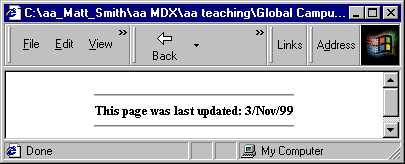
June 2010 Edition
Computer Science Department, University of Cape Town
 | MSc-IT Study Material June 2010 Edition Computer Science Department, University of Cape Town |
A good example of a function that uses more complex JavaScript features, such as arrays and objects (see later unit), is a function to perform the standard task of displaying the date which a Web page was last updated. For example a 'banner' can be displayed at the end of each document as follows:

The code to create such output is as follows:
<HTML> <SCRIPT> <!--
//function called update()
function update()
{
//declare a variable called
// (Modified to equal date of last save)
var modified = document.lastModified;
var months = new
Array("Jan","Feb","Mar","Apr","May","June","July","Aug",
"Sept","Oct","Nov","Dec");
//declare a variable called ModDate to equal last modified
date
var modDate = new Date( modified );
//write string of html formatting
document.write('<center><hr width=200><font size=2><b>');
document.write('This page was last updated: ');
//write day
document.write( modDate.getDate() + '/');
//write month
document.write( months[ modDate.getMonth() ] + '/');
//write year
document.write(modDate.getYear());
//write string of html formatting
document.write('</b></font><br><hr width=200></center>');
}
//invoke function
update()
// --> </SCRIPT> </HTML>
You may wish to examine this function now, and perhaps revisit it after working through the arrays and objects unit later in this module.